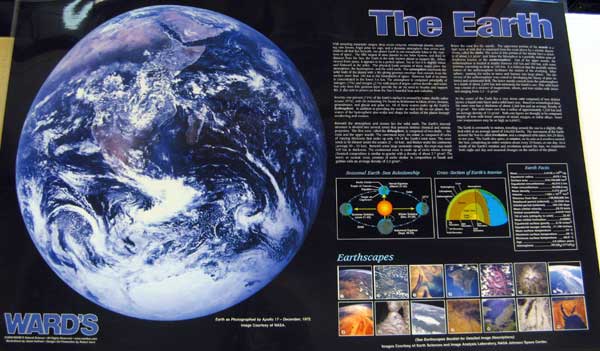THE EARTH
The image below is a photo of the exhibit poster. A text transcript follows.

Poster from Ward's -- 2003. Illustration by Jesse Gotham; Design/Art production by Robert Verni.
With towering mountain ranges, deep ocean canyons, windswept deserts, steaming rain forests, frigid polar ice caps, and a dynamic atmosphere that covers and shelters all that lies beneath, our planet Earth is one remarkable Eden in the vastness of space. The fifth largest of nine planets in our Solar System, and third in distance from the Sun, the Earth is the only known planet to support life. When viewed from space, it appears to be a perfect sphere, but in fact it is slightly oblate and flattened at the poles. The physical Earth consists of three major parts: the atmosphere, the hydrosphere, and the solid earth. The atmosphere surrounds the solid body of the planet with a life-giving gaseous envelope that extends from the surface more than 100 km to the boundaries of space. However, half of its mass is concentrated in the lower 5.6 km. The atmosphere is composed principally of nitrogen (77%) and oxygen (21%) with traces of argon, carbon dioxide, and water. Not only does this gaseous layer provide the air we need to breathe and support life, it also acts to protect us from the Sun's harmful heat and radiation.
Seventy-one percent (71%) of the Earth's surface is covered by water, chiefly saline oceans (97%), with the remaining 3% found as freshwater in lakes, rivers, streams, groundwater, and glacial and polar ice. All of these waters make up the Earth's hydrosphere. In addition to providing the water so vital to life on our planet, the waters of the hydrosphere also sculpt and shape the surface of the planet through weathering and erosion.
Beneath the atmosphere and oceans lies the solid earth. The Earth's internal structure is divided into several zones that possess distinct chemical and seismic properties. The first zone, called the lithosphere, is comprised of two shells -- the crust and the upper mantle. The outermost layer, the crust, is composed of rocks of varying thickness that make up only 1% of the Earth's total mass. The crust tends to be thinner under the oceans (5-10 km), and thicker under the continents (average 30-35 km). Beneath some large mountain ranges, the crust may reach 100 km in thickness. The continental crust is made up of rocks whose average chemical composition is similar to granite with a density of about 2.7 g/cm3. The lower, or oceanic crust, consists of rocks similar in composition to basalt and gabbro with an average density of 3.0 g/cm3.
Below the crust lies the mantle. The uppermost portion of the mantle is a rigid layer of rock that is separated from the crust above by a seismic discontinuity called the Moho. The rocks in this portion of the mantle have a density of about 3.3 g/cm3. Just below the lithosphere is a partially molten zone of weakness known as the asthenosphere. Part of the upper mantle, the asthenosphere is located at depths between 100 km and 350 km, with some portions extending as deep as 700 km. It is believed that the partially molten nature of the asthenosphere facilitates the motion of the overlying lithosphere, causing the rocks to move and fracture into large plates. The discovery of the asthenosphere was central to developing the theory of plate tectonics and continental drift. The lower mantle extends from the asthenosphere to a depth of about 2,890 km and surrounds the Earth's core. This solid layer may consist of a mixture of magnesium, silicon, and iron oxides with densities ranging from 3.3 to 6 g/cm3.
At the center of the Earth lies a very dense core composed of two distinct layers: a liquid outer layer and a solid inner core. Based on seismological data, the outer core has a thickness of about 2,260 km and an average density of 10 g/cm3. The solid inner core has a radius of approximately 1,220 km and an average density of 13 g/cm3. Both core layers are thought to be composed largely of iron with lesser amounts of nickel, oxygen, or sulfur alloys. Inner core temperatures may be as high as 6,650°C.
The Earth is constantly in motion, traveling around the sun in a slightly elliptical orbit at an average speed of 106,000 km/hr. The movement of the Earth around the Sun is called revolution, and a completed orbit takes 365.24 days, or one year. The Earth also spins, or rotates, on its axis as it revolves around the Sun, completing an entire rotation and revolution around the Sun, we experience both night and day and seasonal changes on the surface of the planet.
Image captions:
- Earth as Photographed by Apollo 17 -- December, 1972. Image Courtesy of NASA.
- 13 Earthscapes Images (Detailed image descriptions in booklet)
- Seasonal Earth-Sun Relationship: Arctic Circle, Tropic of Cancer, Equator, Tropic of Capricorn, Vernal Equinox (March 21-22), Orbit, 23.5° tilt, Winter Solstice (Dec. 21-22), Autumnal Equinox (Sept. 22-23), Summer Solstice (June 21-22)
- Cross-Section of Earth's Inerior: Atmosphere, Crust, Hydrosphere, Lithosphere, Mantle, Outer Core, Inner Core
Image credits: Earth Sciences and Image Analysis Laboratory; NASA Johnson Space Center.
EARTH FACTS
Mass 5.976 x 1024 kg
Equatorial radius 6378.1 km
Surface area 510,100,000 km2
Equatorial circumference 40,076.5 km
Polar circumference 40,008.6 km
Mean density 5.515 g/cm3
Volume 1.083 x 1012 km3
Distance from Sun 149,600,000 km
Rotational period (sidereal) 23.9345 hrs
Orbital period (sidereal) 365.256 days
Mean orbital velocity 29.78 km/s
Orbital eccentricity 0.01671022
Tilt of axis (obliquity to orbit) 23.45°
Mean orbital inclination 0.00005°
Equatorial surface gravity 9.78 m/sec2
Equatorial escape velocity 11.186 km/sec
Mean surface temperature 14° C
Maximum surface temperature 58° C
Minimum surface temperature -89.6° C
Age 4.6 billion years
Atmosphere 78%(N2) 21%(O2)